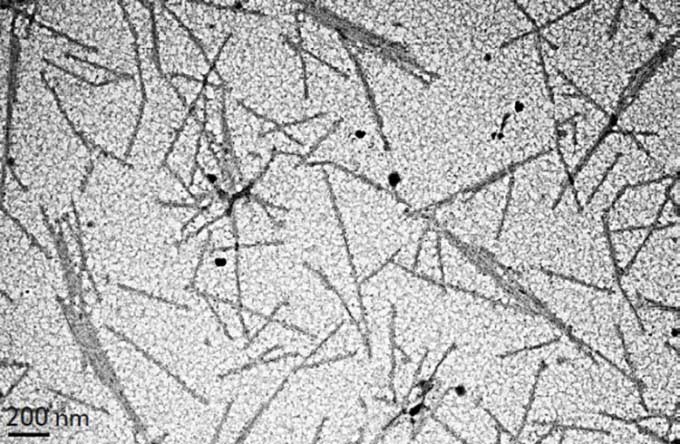Viruses have existed for billions of years but were only scientifically described around the late 19th century, with the first virus being the tobacco mosaic virus.
The first step leading to the discovery of viruses occurred in 1876 when Adolf Mayer, a German agricultural chemist and director of the Agricultural Experiment Station in Wageningen, described a peculiar leaf spot disease on tobacco plants. He believed the disease was caused by bacteria or fungi, but microscopic examination and tests failed to detect any organisms.

Tobacco mosaic virus under a transmission electron microscope (TEM). (Photo: Research Gate).
A breakthrough occurred in 1892 with Russian botanist Dmitri Ivanovsky. He discovered that sap from infected plants remained infectious even after passing through a bacterial filter. Ivanovsky realized he had found something new.
In 1898, Dutch microbiologist Martinus Beijerinck independently repeated Ivanovsky’s experiment and provided a somewhat clearer interpretation. Beijerinck argued that the experiment showed that tobacco mosaic disease did not originate from bacteria but from an “infectious living fluid.” He began using the term “virus” to describe the “non-bacterial” nature of the pathogen.
During this time, experts discovered several other pathogens that could also pass through bacterial filters, including hand-foot-and-mouth disease, rabbit ringworm, African horse sickness, and chicken plague. However, the exact nature of this “invisible” pathogen remained unclear.
Identifying the cause of yellow fever was a significant milestone in virology. During the Spanish-American War in 1898, American troops were afflicted by this disease upon reaching the shores of Cuba. Thanks to research by Walter Reed, James Carroll, Aristides Agramonte, and Jesse William Lazear, it was established that the disease could be transmitted through serum filtered from a patient. This discovery made yellow fever the first infectious disease in humans identified as caused by a virus.
By 1931, with the invention of the electron microscope, scientists could finally see viruses. Once again, the tobacco mosaic virus became the first virus to be photographed.
Another important moment occurred in the 1950s with the research of Rosalind Franklin. She used X-ray crystallography to determine that the structure of the tobacco mosaic virus is a single-stranded RNA molecule surrounded by a protein coat. Her other research helped demonstrate that DNA is a double-stranded molecule, leading to the famous discoveries about the double helix structure of DNA.
Over a century after this discovery, viruses continue to perplex and astonish scientists and can still cause disasters. Today, there is still much debate about whether viruses are “living” entities.
Viruses are efficient parasitic organisms. They require a living cell to reproduce and cannot grow independently outside the host, unlike bacteria and other free-living microorganisms. However, they are made up of DNA or RNA — components that play critical roles in life. Most scientists today believe that viruses qualify as “living,” even as they continue to surprise us with new discoveries.


















































